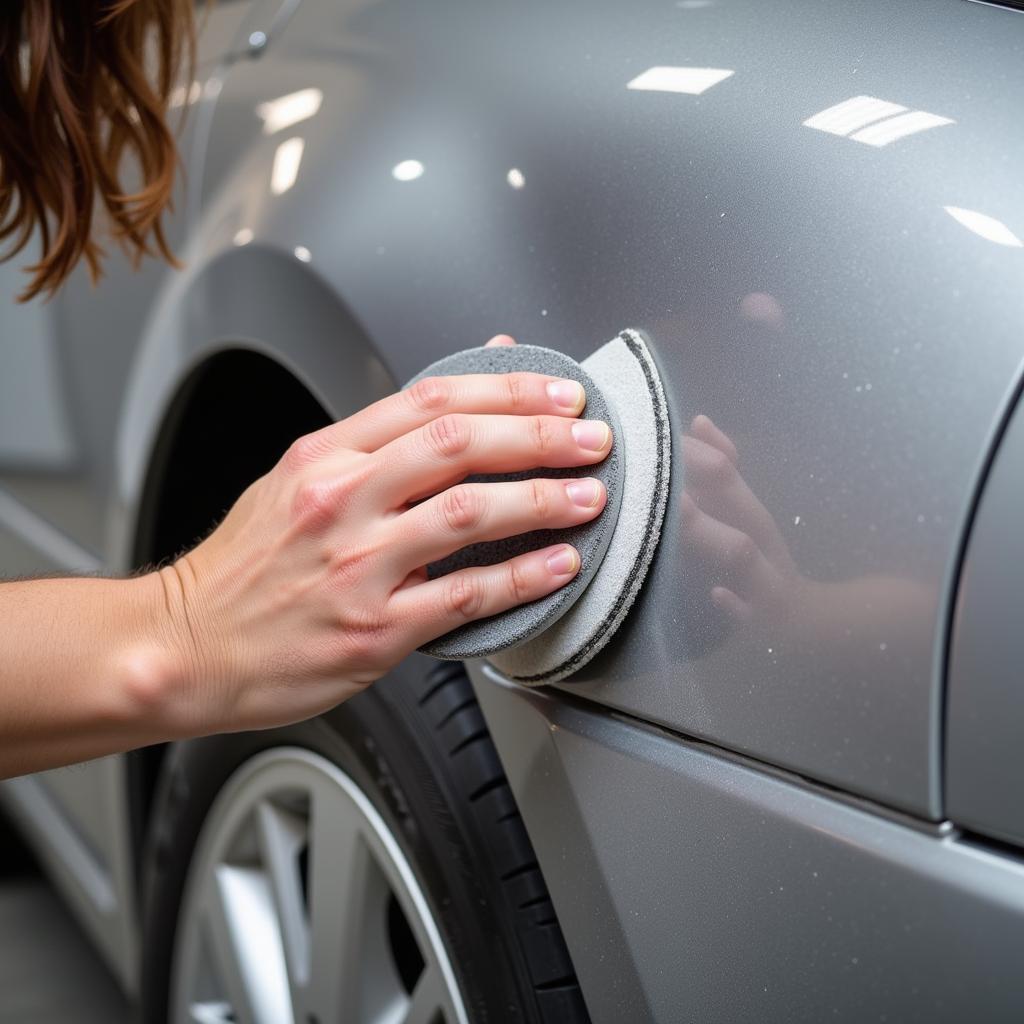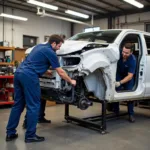If you’ve noticed your car paint is blistering, you’re likely wondering what caused it and, more importantly, can you repair it? Blistering paint, also known as bubbling or lifting, isn’t just an eyesore; it can lead to more serious problems like rust and corrosion if left untreated. This comprehensive guide will walk you through the causes, repair options, and preventative measures for dealing with blistering car paint. Let’s dive in and get your car looking its best again.
Understanding Why Your Car Paint is Blistering
Several factors can cause car paint to blister, ranging from environmental factors to improper painting techniques. Identifying the root cause is crucial for effective repair and prevention.
- Moisture: Trapped moisture between the paint layers is a common culprit. This can occur due to leaks, condensation, or even washing your car with high-pressure water. The moisture creates pressure, causing the paint to lift and blister.
- UV Exposure: Prolonged exposure to the sun’s harmful UV rays can weaken the paint’s chemical bonds, making it more susceptible to blistering, especially in hotter climates.
- Poor Surface Preparation: If the surface wasn’t properly cleaned and prepped before painting, contaminants like dirt, grease, or rust can prevent the paint from adhering correctly, leading to blisters.
- Low-Quality Paint: Using inferior quality paint or incorrect paint application techniques, such as applying too thick a coat, can also contribute to blistering.
- Chemical Exposure: Certain chemicals, like road salt or industrial pollutants, can react with the paint and cause it to blister.
After cleaning your car, consider using a high-quality wax to protect the paint. You can find more information on maintaining your car’s paint job at repair of blistering car paint.
Can You Repair Blistered Car Paint Yourself?
Yes, minor blistering can often be repaired at home with some patience and the right tools. However, extensive or severe blistering might require professional attention.
DIY Repair for Minor Blistering
- Clean the Affected Area: Thoroughly wash and dry the area with blistering paint.
- Sand the Blisters: Carefully sand the blistered area using fine-grit sandpaper until the surface is smooth and even.
- Prime the Area: Apply a thin, even coat of automotive primer to the sanded area.
- Apply Paint: Once the primer is dry, apply several thin coats of matching automotive paint, allowing each coat to dry completely before applying the next.
- Apply Clear Coat (Optional): For added protection and shine, apply a clear coat after the paint has dried.
For more specific instructions on DIY repair, check out our guide on how to repair blistered car paint. Remember to always follow the manufacturer’s instructions for any products you use.
When to Seek Professional Help
While minor blistering can be a DIY project, larger areas or deeply rooted blisters are best left to the professionals. They have the expertise and tools to address the underlying issues and ensure a long-lasting repair. You might want to consider the paint bubbling on car hood repair cost if the damage is on your hood.
Signs You Need a Professional
- Large Areas of Blistering: If the blistering covers a significant portion of the car panel, it’s best to consult a professional.
- Deep Blisters: Blisters that penetrate deep into the paint layers often indicate a more serious problem and require professional repair.
- Rust or Corrosion: If you notice rust or corrosion under the blistered paint, it’s crucial to get it addressed by a professional immediately to prevent further damage.
A professional can also advise on using a car paint rust repair kit for smaller rust spots that might appear.
Preventing Car Paint Blistering
Prevention is always better than cure. By taking a few simple precautions, you can significantly reduce the risk of your car paint blistering.
- Regular Washing and Waxing: Regularly washing your car and applying a protective wax coating can help shield the paint from environmental damage.
- Proper Storage: Whenever possible, park your car in a garage or shaded area to minimize UV exposure.
- Address Leaks Promptly: Repair any leaks in your car’s body or windows as soon as possible to prevent moisture buildup.
- Careful Washing Techniques: Avoid using high-pressure water when washing your car, as this can force water under the paint.
Conclusion
Blistering car paint can be a frustrating issue, but understanding the causes and implementing proper repair and preventative measures can keep your car looking its best. While minor blistering can be tackled with a DIY approach, don’t hesitate to seek professional help for more extensive damage. By following the advice in this article, you can address the problem of your car paint blistering effectively and prevent it from recurring. Need more help? Consider learning about repair blistered paint on car.
FAQ
- What causes car paint to blister in the first place? Moisture, UV rays, poor surface preparation, low-quality paint, and chemical exposure can all contribute.
- Can I repair blistered paint myself? Yes, minor blistering can often be repaired at home.
- When should I call a professional? For large areas of blistering, deep blisters, or if you notice rust.
- How can I prevent blistering? Regular washing, waxing, proper storage, and addressing leaks promptly.
- What tools do I need for a DIY repair? Sandpaper, primer, paint, clear coat (optional), and basic cleaning supplies.
- How much does professional repair cost? It depends on the severity and extent of the damage.
- Does car insurance cover paint blistering? It depends on your specific policy and the cause of the blistering.
Common Scenarios
- Blistering after a car wash: Likely caused by high-pressure water.
- Blistering on the hood: Likely due to UV exposure and engine heat.
- Blistering around a repaired area: May indicate improper surface preparation during the repair.
Further Exploration
For more information on related topics, explore our articles on car paint maintenance, rust repair, and DIY car care.
Need help with your car’s paint? Contact us via WhatsApp: +1(641)206-8880, or Email: [email protected]. We have a 24/7 customer support team ready to assist you.



